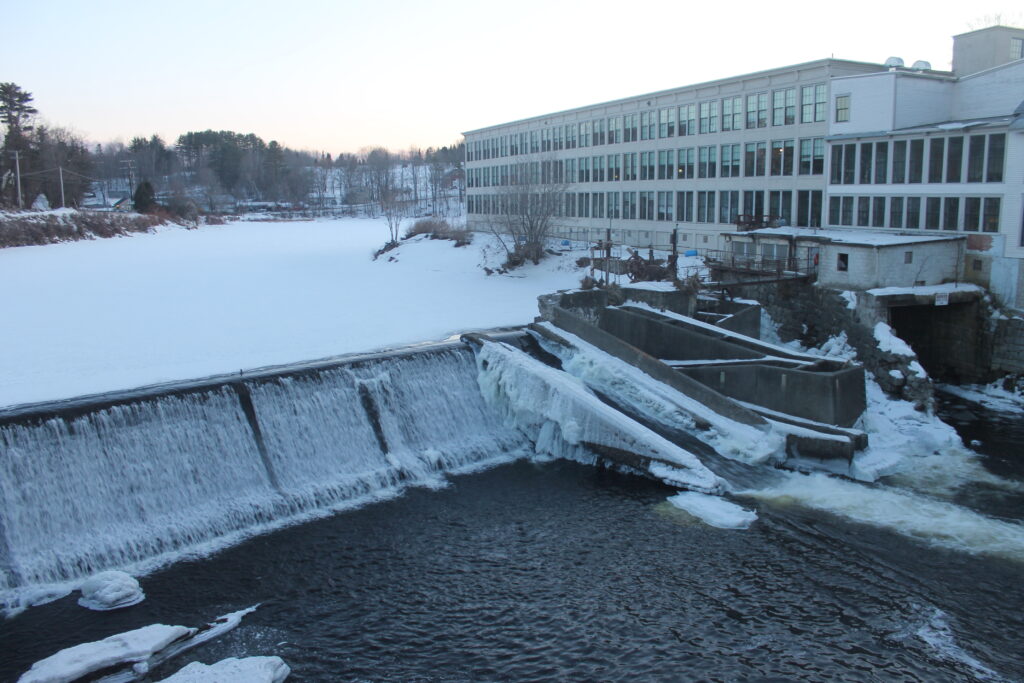
Mayo Mill Dam removal question to be on June referendum
DOVER-FOXCROFT — At last month’s public forum the Mayo Mill Dam steering committee presented its recommendation that removing the dam and connecting facilities and building a riverfront park is in the town’s best interests moving forward. Reducing flooding dangers, improving the area’s ecology, including fish passage, and the availability of funding for dam removal are among the main reasons for the committee’s conclusion.
During a select board meeting on Monday, Feb. 26 town officials voted to accept the recommendation – 6-1 with Select Person Joel Vail being the “no” vote. The board also voted 7-0 to place a question on the June referendum ballot pertaining to the project.
At last month’s forum the topic on whether the town should accept grant funds or not for the dam removal project was mentioned as a way to gauge if residents favor the plan or not.
“The select board does not have the final say, the voters of Dover-Foxcroft have the final say,” Select Chairperson Tom Lizotte said.

MAYO MILL DAM — The Mayo Mill Dam on the Piscataquis River in downtown Dover-Foxcroft. During a meeting Monday evening, the select board voted to accept a steering committee recommendation to remove the structure and place a question concerning the project on the June ballot.
A board subcommittee, such as administration, will review the question language drafted by Town Manager Jack Clukey in consultation with legal counsel. The language would be finalized by late March, and a public hearing would be scheduled before June.
“So no one is confused by what the question means,” Clukey said.
Following public comment, in which the majority of the 24 participants spoke in opposition to removing the dam, the steering committee made its presentation. Member Chris Maas said the first meeting took place in January 2023 and there was a consensus to see that part of town as a vital meeting place.
Maas said the Federal Energy Regulatory Commission, which oversees the Dover-Foxcroft site and other hydroelectric dams, had been in communication with the town for over a decade to have something done about the structure’s safety deficiencies. More than a decade and a half has passed since the dam on the Piscataquis River downtown has produced energy. In the years since, the town-owned structure has remained in place but has been deteriorating under the continual water flow.
Atlantic salmon were listed under the Endangered Species Act in 2000 and the fish travel up and down the Piscataquis River. The river was deemed to be critical habitat in 2009, so the dam needs to be compliant in this area which would have costs aside from safety improvements.
The steering committee met monthly, Maas said all documents including a feasibility study recommendation report are available at https://www.mayomilldamstudy.com. He said speaking for himself and he believed for the group, “As time went on, we changed.”
Maas said in July the consulting engineer presented 23 different options for the dam site along with 13 different evaluation criteria topics to evaluate each. Maas went through all possibilities and “I was surprised I ended with the option taking the dam out was at the top of the list” with keeping it in place at the bottom.
The report says that in the end returning the Piscataquis River to its natural, free-flowing state, and working to create a riverfront as part of downtown revitalization efforts, was seen as the best solution for the community. Steering committee members cited the need to reduce flooding dangers (this was a month prior to the Dec. 18 flood), improvement of fish passage, and the availability of both public and private funding for dam removal as the compelling reasons for recommending this action to the select board.
The dam project would follow a 6- to 8-year timeline, Maas said. He said following affirmative votes by the select board later that evening, there would be a needed detailed project design that would take about a year to complete. There also would be a funding search with project partners looking into various sources.
The committee looked at the dam site now with the potential millions of dollars in funding opportunities for revitalization as part of the larger downtown. Dover-Foxcroft is working on adjacent projects concerning vehicle movement and pedestrian access for sustainable long-term solutions. There is also money available to mitigate the flood issues caused by the dam..
“We have time, we have a once in a lifetime opportunity to fix these issues,” Maas said, mentioning a ballpark figure of $6-8 million.
Atlantic Salmon Federation Project Manager Maranda Nemeth said the organization would work with the town. “We would commit to all of those steps and we are confident we could secure that funding,” she said.
The first dam at the site was built in 1920 with concrete and the current dam was constructed in 1980. The Mayo Mill Dam is 12 feet high and 150 feet in length with a 30-acre impoundment. The dam provided electricity for Moosehead Manufacturing until the company shuttered in early 2007.
The mill property was conveyed to Dover-Foxcroft, and since then the building has been redeveloped into a multi-use facility with apartments, boutique hotel, cafe, and office space. The hope was to restore hydropower production to provide electricity to adjacent properties.
From about 2010-21 there was a process to try to find a way to restart the dam. The town consulted with multiple engineers, turbine suppliers, and a private developer for years to identify a hydropower retrofit and determined that there are no economically viable options — in part due to the small size of the dam – as there would not be a payback for at least several decades.
“As the owner, landlord we answer to FERC,” Clukey said. He said in both 2013 and 2018 the agency asked that the town’s plan for the dam was, and this was put off both times.
“They’re not asking what the plan is, they are saying you need to immediately address those issues at the site,” the town manager said.
“We’re in a regulatory environment and we have to comply with FERC’s regulations,” Clukey said. When asked, he said there would be hundreds of thousands of dollars in needed immediate repairs if dam removal is not pursued.
“There’s no do nothing option that doesn’t represent a significant expense,” Clukey said.
“The price of admiring that view is extremely costly,” Lizotte said. He mentioned a figure of $7.5 million for full repairs, little to nothing of which could be covered by grants that are only available for removal.
“There is no escaping our responsibility of doing something about that cement barrier in the Piscataquis River,” Lizotte said.